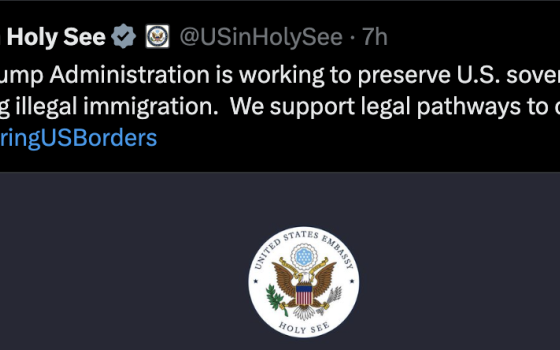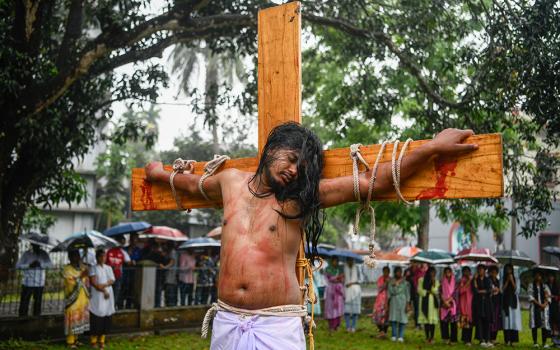ROME -- You can often tell how upset someone is with a story by how many statements they put out denying it, and how detailed those statements are. By that standard, the Vatican seems mightily piqued indeed by the recent scandal surrounding Italian Archbishop Carlo Maria Viganò – which is one part about Viganò’s charges of financial corruption, and another about his exposing internal Vatican power politics.
On Saturday, the Vatican issued a second lengthy statement on the Viganò mess, this one signed by a cardinal, a cardinal-to-be, and two other senior officials.
Viganò is today the pope’s nuncio, or ambassador, in the United States, but from 2009 to 2011 he served as the number two official in the government of the Vatican city-state. It’s responsible for the physical 108-acre Vatican territory, including operations such as the Vatican museums, gardens and post office, as opposed to institutions or funds directed at the universal church.
In that role, Viganò earned a reputation as a financial reformer by cutting costs, employing centralized accounting, and imposing consequences for cost overruns.
The current scandal broke in late January, when the Italian TV program “The Untouchables” revealed confidential letters written by Viganò in 2011, as rumors of his transfer to Washington began to swirl.
In one, Viganò told Pope Benedict XVI that his removal would disillusion all those hoping to clean up “corruption and dishonesty” in the city-state, including contracts awarded on the basis of cronyism, at inflated prices, and bankers who manage Vatican investments with an eye to their own interests more than those of the church.
A second letter from Viganò, addressed to Cardinal Tarcisio Bertone, the Vatican’s Secretary of State, complained of a campaign of defamation against him inside the Vatican, openly naming names as the alleged ringleaders. They include an Italian monsignor who works at the Vatican museums, and a well-known Italian layman who’s held senior positions both in the Vatican and at the Italian public broadcaster RAI, and who’s viewed as especially close to Bertone.
Viganò accused both figures of various forms of misconduct, and accused both of being the source of “calumnious judgments, evil insinuations [and] lies” circulating within the Vatican, intended to discredit him with Bertone.
The Vatican’s first official statement on the story came on Jan. 26, in a lengthy declaration from Jesuit Fr. Federico Lombardi, the Vatican spokesperson. In a nutshell, it asserted that Viganò’s departure did not signal any retreat from “transparency and rigor” in financial administration.
That letter was read in full last Wednesday on the Italian TV program that originally revealed the letters, along with yet another leaked missive from 2011 – this one from a former papal nuncio in the States, 85-year-old Italian Cardinal Agostino Cacciavillan, to Benedict XVI, arguing that Viganò should be left on the job in Rome.
The host of the Italian program, journalist Gianluigi Nuzzi, said that with new developments arriving on a daily basis, the Viganò scandal seems ever more an “affair of state,” and that they would continue to follow it.
The story took another turn with Saturday’s statement from the top brass at the government of the city-state. It’s co-signed by Cardinal Giovanni Lajolo, the former president of the city-state (and thus Viganò’s former boss) and the current top man, Cardinal-designate Giuseppe Bertello, along with two other officials.
The statement was also printed, in full, in both L’Osservatore Romano, the Vatican newspaper, and in Sunday’s edition of L’Avvenire, the official newspaper of the Italian bishops.
t
It begins by saying that Viganò’s letters create the impression that the government of the city-state is “an untrustworthy entity in the grip of obscure forces.” In fact, it says, Viganò’s charges “are the fruit of an erroneous evaluation, or based on fears not supported by evidence … indeed, openly contradicted by the principal personalities invoked as witnesses.”
A policy of “transparency and rigor”, the statement insists, continues with “equal commitment” after Viganò’s departure. The city-state’s books, it says, are regularly submitted to the Vatican’s Prefecture for Economic Affairs for review.
With regard to contracts, the statement insists that major work is submitted to a competitive bidding procedure, while minor jobs are awarded to Vatican personnel or external firms on the basis of the normal price paid for such work in Italy.
The statement further says that in 2010, the government of the city-state had a surplus of $28 million – due, it says, to the performance of its investments and, even more, to a very good year for the Vatican museums.
The statement also reaffirms the commitment of the city-state to continue to implement recommendations issued by McKinsey and Company, a global management consulting firm originally founded in Chicago, which was hired in 2009 to advise the city-state on finance and administration.
The statement includes a word of praise for the previous team at the city-state, which included Viganò, but there’s no mistaking both the clear rejection of his complaints and considerable annoyance at their having created a cause célèbre.
It remains to be seen whether these two lengthy Vatican missives will mark the end of the affair.
Italian Vatican analyst Sandro Magister, for one, devoted a recent piece in L’Espresso, a major Italian newsmagazine, to arguing that the Viganò affair is the latest indication of mismanagement on the watch of Bertone, whom Magister accused of serving his own agenda more than the pope’s. According to Magister, Bertone’s influence, under the weight of the Viganò revelations and other implosions, is waning: “His trajectory is at an end,” Magister said.
t


